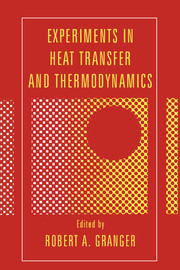Book contents
- Frontmatter
- Contents
- Preface
- Introduction
- Part I Experiments in heat transfer
- I.1 Conduction
- I.2 Convection
- I.3 Boiling
- Experiment 17 Capillary-tube boiling
- Experiment 18 Two characteristic regions of nucleate pool boiling and corresponding change of hydrodynamic state
- Experiment 19 The boiling slide
- Experiment 20 Evaporation and boiling in sessile drops on a heated surface
- I.4 Mixing, dispersion, and diffusion
- I.5 Radiation
- I.6 Heat pipes and exchangers
- Part II Experiments in thermodynamics
- Appendix 1 Experiments and demonstrations in thermodynamics
- Appendix 2 Experiments and demonstrations in heat transfer
- Appendix 3 Heat-transfer and thermodynamic films
- Index
Experiment 18 - Two characteristic regions of nucleate pool boiling and corresponding change of hydrodynamic state
Published online by Cambridge University Press: 05 June 2012
- Frontmatter
- Contents
- Preface
- Introduction
- Part I Experiments in heat transfer
- I.1 Conduction
- I.2 Convection
- I.3 Boiling
- Experiment 17 Capillary-tube boiling
- Experiment 18 Two characteristic regions of nucleate pool boiling and corresponding change of hydrodynamic state
- Experiment 19 The boiling slide
- Experiment 20 Evaporation and boiling in sessile drops on a heated surface
- I.4 Mixing, dispersion, and diffusion
- I.5 Radiation
- I.6 Heat pipes and exchangers
- Part II Experiments in thermodynamics
- Appendix 1 Experiments and demonstrations in thermodynamics
- Appendix 2 Experiments and demonstrations in heat transfer
- Appendix 3 Heat-transfer and thermodynamic films
- Index
Summary
Principle
Existence of two different characteristic regions in nucleate boiling, that is, the region of isolated bubbles at low heat fluxes and the region of interference at high heat fluxes, can be demonstrated by measuring the resultant force acting on a compact heater that is suspended in a pool of liquid with boiling on its upper surface.
Object
As the surface temperature of a heater submerged in a pool of saturated liquid is raised above the saturation temperature, nucleate boiling appears after the incipience of boiling, and then continues up to the point of critical heat flux. In this nucleate-boiling regime, the heat flux from the heated surface to the liquid increases with increasing surface temperature, and the relationship between the heat flux and the surface temperature (the so-called boiling curve) is of a monotonic nature, in most cases exhibiting no noticeable change of character throughout the aforementioned regime. Visual observations by means of a high-speed cine camera, however, reveal that nucleate boiling is divided into two regions. Namely, when the heat flux is low, small isolated bubbles repeat the growth and departure process at a comparatively small number of active nucleation sites on the heated surface, but at high heat fluxes, the heated surface is covered with a thin liquid sublayer (which is generally called the macrolayer) holding numerous tiny vapor jets rooted to nucleation sites, and the vapor fed continuously from these vapor jets accumulates to develop massive vapor slugs successively on the foregoing liquid sublayer.
- Type
- Chapter
- Information
- Experiments in Heat Transfer and Thermodynamics , pp. 135 - 141Publisher: Cambridge University PressPrint publication year: 1994



